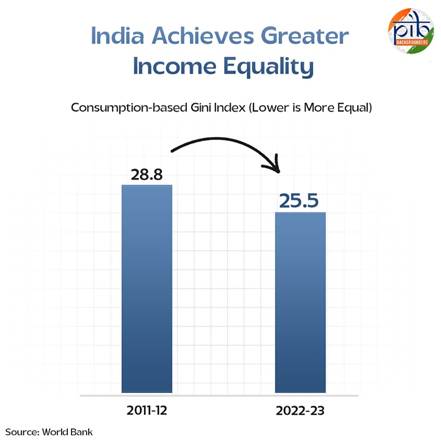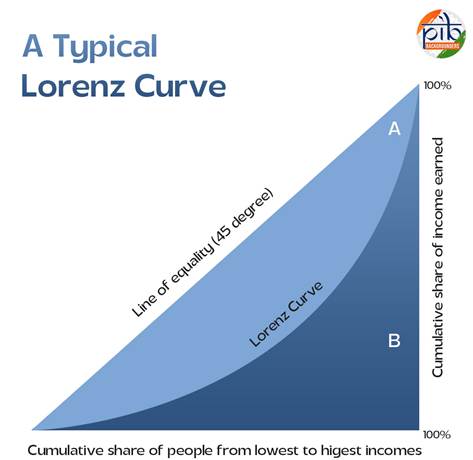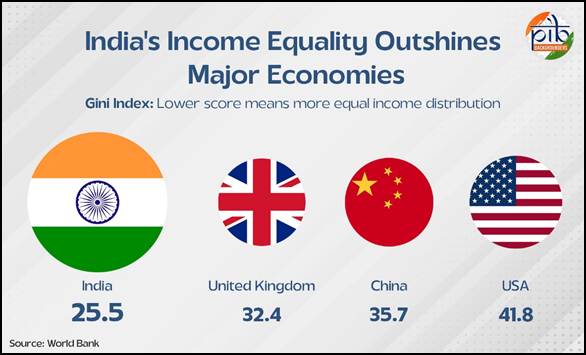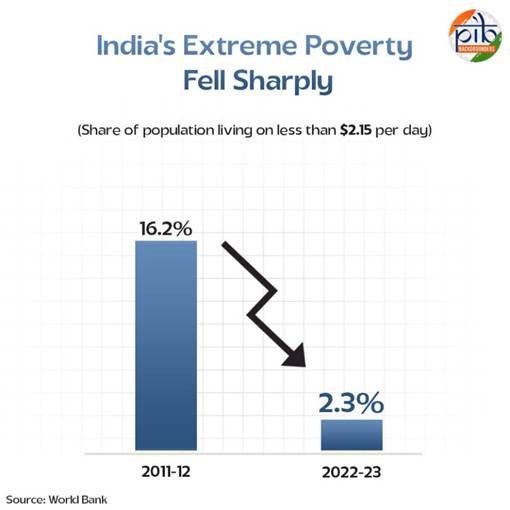Social Welfare
India’s Story on Bridging Inequality
World Bank Places India Among World’s Most Equal Societies
Posted On: 05 JUL 2025 10:20AM
Key Takeaways
- India ranks fourth globally in income equality with a Gini score of 25.5.
- Extreme poverty dropped to 2.3% in 2022-23, says World Bank
- 171 million Indians moved out of extreme poverty between 2011–23.
Introduction

India is not only the world’s fourth largest economy; it is also one of the most equal societies today. According to the World Bank, India’s Gini Index stands at 25.5, making it the fourth most equal country in the world, after the Slovak Republic, Slovenia and Belarus. This is a remarkable achievement for a country of its size and diversity. It reflects how India’s economic progress is being shared more evenly across its population. Behind this success is a consistent policy focus on reducing poverty, expanding financial access, and delivering welfare support directly to those who need it most.
Understanding the Gini Index
The Gini Index is a simple yet powerful way to understand how equally income, wealth or consumption is distributed across households or individuals in a country. It ranges in value from 0 to 100. A score of 0 means perfect equality. A score of 100 means one person has all the income, wealth or consumption and others have none, hence absolute inequality. The higher the Gini Index the more unequal the country.

Graphically Gini Index can be explained by the Lorenz curve. A Lorenz curve plots the cumulative percentages of total income received against the cumulative number of recipients, starting with the poorest individual or household. A perfectly equal distribution will be shown by a diagonal line, while the actual distribution will be shown by the Lorenz curve. The Gini index measures the area between the Lorenz curve and a hypothetical line of absolute equality, or the gap between the two, expressed as a percentage of the maximum area under the line. The bigger the gap, the more unequal the income. This gives one clear number to show how fairly income is spread.
India’s Global Standing in Equality
According to the latest World Bank data, India’s Gini Index stands at 25.5. This places India among the most equal countries in the world in relative terms. India’s score is much lower than China’s 35.7 and far lower than the United States, which stands at 41.8. It is also more equal than every G7 and G20 country, many of which are considered advanced economies.

India falls into the “moderately low” inequality category, which includes Gini scores between 25 and 30, and is only a fraction away from joining the “low inequality” group, which includes countries like the Slovak Republic with a score of 24.1, Slovenia at 24.3, and Belarus at 24.4. Apart from these three, India has a better score than all of the other 167 countries for which the World Bank has released data.
Globally, just 30 countries fall into the “moderately low” inequality category. including several European countries with strong welfare systems. These include Iceland, Norway, Finland, and Belgium. It also features growing economies like Poland and wealthy nations like the United Arab Emirates.
India’s journey towards a more equal society is reflected in its Gini Index over the years. The index was measured at 28.8 in 2011, and reached 25.5 in 2022. This steady shift shows that India has made consistent progress in combining economic growth with social equity.
Poverty Reduction Driving Greater Equality
India’s strong standing on the Gini Index is not a coincidence. It is closely linked to the country’s sustained success in reducing poverty across both rural and urban regions. The Spring 2025 Poverty and Equity Brief by the World Bank highlights this achievement as one of the most significant in recent years.
According to the report, 171 million Indians have been lifted out of extreme poverty over the past decade. The share of people living on less than 2.15 US dollars a day, which was the global threshold for extreme poverty till June 2025, fell sharply from 16.2 percent in 2011-12 to just 2.3 percent in 2022-23. Under World Bank’s revised extreme poverty threshold of $3.00 per day, the 2022-23 poverty rate would be adjusted to 5.3 percent.

Key Government Initiatives
India’s progress towards greater income equality is backed by a series of focused government initiatives. These schemes aim to improve financial access, deliver welfare benefits efficiently, and support vulnerable and underrepresented groups. Together, they have helped bridge gaps, boost livelihoods, and ensure that growth reaches all sections of society.
Some of the key schemes and initiatives are:
- PM Jan Dhan Yojana: Financial inclusion has been at the heart of India’s social equity push. As of June 25, 2025 over 55.69 crore people hold Jan Dhan accounts, giving them direct access to government benefits and formal banking services.
- Aadhaar and Digital Identity: Aadhaar has enabled the creation of a unique digital identity for residents across the country. As of July 3, 2025, more than 142 crore Aadhaar cards have been issued. This system forms the backbone of welfare delivery by ensuring that benefits reach the right person at the right time through reliable authentication.
- Direct Benefit Transfer (DBT): The DBT system has streamlined welfare payments, reducing leakages and delays. Cumulative savings have reached ₹3.48 lakh crore as of March 2023, reflecting its efficiency and scale.
- Ayushman Bharat: Access to quality healthcare is key to improving social equity. The Ayushman Bharat scheme provides health coverage of up to ₹5 lakh per family per year. As of July 3, 2025, over 41.34 crore Ayushman Cards have been issued. The scheme is supported by more than 32,000 empanelled hospitals across the country. In addition, the government launched the Ayushman Vay Vandana scheme to extend this coverage to all citizens aged 70 and above, regardless of income. The Ayushman Bharat Digital Mission has further strengthened this effort, with over 79 crore health accounts created to link individuals to digital health services.
- Stand-Up India: To promote inclusive entrepreneurship, the Stand-Up India scheme provides loans between ₹10 lakh and ₹1 crore to SC/ST and women entrepreneurs for setting up greenfield enterprises. As of July 3, 2025, more than 2.75 lakh applications have been sanctioned, with total funding of ₹62,807.46 crore. This initiative empowers individuals from disadvantaged communities to participate in economic growth on their own terms.
- Pradhan Mantri Garib Kalyan Anna Yojana (PMGKAY): Food security remains a pillar of social protection. Launched during the COVID-19 pandemic, PMGKAY has continued to serve the most vulnerable sections of society. As of December 2024, the scheme has reached 80.67 crore beneficiaries, offering free food grains and ensuring that no one is left behind during times of crisis.
- PM Vishwakarma Yojana: Traditional artisans and craftspeople are vital to India’s economic and cultural fabric. The PM Vishwakarma Yojana supports them with collateral-free loans, toolkits, digital training, and marketing support. As of July 3, 2025, 29.95 lakh individuals have registered under the scheme, helping preserve livelihoods and promote inclusive growth across rural and semi-urban areas.
Conclusion
India’s path to income equality has been steady and focused. The Gini Index of 25.5 is not just a number. It reflects real change in people’s lives. More families now have access to food, banking, healthcare, and jobs.
What sets India apart is its ability to balance economic reform with strong social protection. Targeted schemes like Jan Dhan, DBT, and Ayushman Bharat have helped close long-standing gaps. At the same time, programmes such as Stand-Up India and PM Vishwakarma Yojana are helping people create wealth and secure livelihoods on their own terms.
As the world looks for models that combine growth with fairness, India’s example stands out. Its experience shows that equality and development are not separate goals. When supported by sound policy and inclusive intent, they move forward together.
References:
World Bank:
PIB Backgrounders:
ORF:
Click here to see pdf
****
SK/M
(Backgrounder ID: 154837)
Visitor Counter : 1515